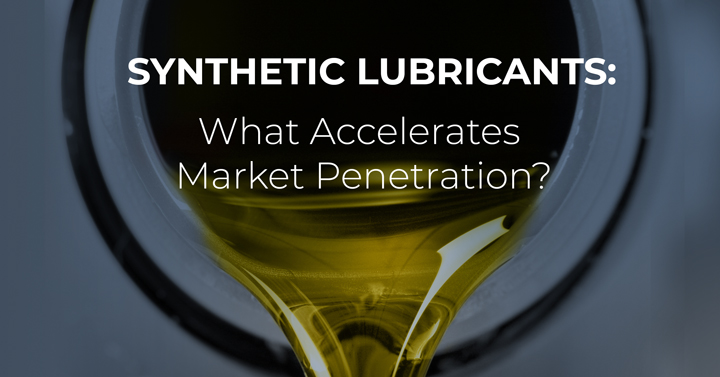Synthetic lubricants remain the industry’s sweet spot. Estimated to increase at a CAGR of 7.4% between 2020 and 2025, full synthetics are outpacing the overall market growth and making this product segment the focus growth area for most lubricants suppliers. Semi-synthetics are poised to grow at a slower pace, albeit a solid one. The traditional factors including ever-stricter emission regulations, fuel economy requirements, and industry engine oil specifications continue to be key drivers. However, many new developments have been shaping the industry.
North America and Europe are expected to have the highest penetration of full synthetics by 2025. Automotive users in these mature markets have long benefited from the advantages of synthetics. Euro 6/VI emission standards have been adopted in Europe since 2015.
Emissions regulations are catching up quickly with these European standards, with countries such as China and India implementing the latest Euro 6/VI equivalent emissions regulations. India even bypassed BS-V (Euro 5) and skipped directly to BS-VI standards. This is having a major impact on OEMs, driving them to upgrade their technology and the corresponding lubricants used in their vehicles, especially in regions that were typically a generation or two behind Europe and North America. China has even gone toward making obsolete National III-compliant commercial vehicles. Most recently, Australia is considering a move to Euro 6/VI by 2027. As other countries continue to adopt Euro 6/VI, their consumption of higher performance lubricants is expected to grow as well.
The focus on sustainability, strengthened by the COVID-19 pandemic, along with existing and new government stimulus, plus technological advancements, particularly in the field of battery technology, accelerated the automotive industry’s shift toward electric vehicles (EVs). While the growth in EVs is contributing to lower consumption of consumer automotive lubricants, synthetics and semi-synthetics are expected to benefit with the transition as most EVs require advanced quality lubricants.
From a regional perspective, North America and Europe led the synthetic lubricant consumption, accounting for 33% to 34% of these markets, and Asia-Pacific followed at 31% in 2020. In North America, the United States accounted for 85% of the region’s demand for synthetic lubricants. The continued drive for lower emissions and more fuel-efficient yet powerful vehicles is driving growth for synthetic lubricants in the consumer automotive segment, which was highly affected in early 2020 during the lockdown period; it is now rebounding.
The U.S. market is showcasing a multitude of trends occurring in the synthetics market. Most OEMs in the United States have started using lighter viscosity grades like 0Ws in factory fill and recommend the same for service fill applications as well.
Several suppliers engage in innovation with better packaging for lubricants to promote convenience as well as sustainability. Valvoline launched a new gear oil packaging called FlexFill pouches. Chevron is also promoting its new packaging under the tagline “SMART CHANGE.” It is offering passenger car lubricants in cardboard boxes of six quarts, made of 70% less plastic compared to plastic bottles. These boxes are claimed to carry 20% more oil and are easy to use.
Private-label brands have been able to increase their market shares in the past several years in the synthetic lubricants market in the United States. Private-label products are easily available on e-commerce websites, which act as an important channel for sales. Moreover, consumers are unaware of the other differences in formulation between an entry-level and a premium product and will choose a cheaper full synthetic from an established private-label brand.
High mileage products are recommended for vehicles that have covered more than 75,000 miles and are offered in a few country markets, such as the United States, Vietnam, Russia, United Kingdom, and Brazil. However, demand for high mileage lubricants is expected to slowly decline in the United States over the years as the market moves extensively to full synthetic products. High mileage products have been available for passenger cars for a long time in this market, but their acceptance is slowly declining due to the absence of a strong push from key stakeholders and due to high prices.
Demand growth for synthetics will vary from one region to another and across segments. Demand for synthetic PCMO grades is expected to grow at a fast pace over the next five years as a result of the introduction of new specifications, such as GF-6 by ILSAC. While the penetration of turbocharged engines must be closely watched to see if the trend of moving toward 0Ws has slowed in favor of 5Ws, it is mainly semi-synthetic and synthetic 5W-30s being recommended in these applications.
API CK-4 and FA-4 are driving semi-synthetic and synthetic engine oil use in the commercial segment. OEMs are recommending semi-synthetic 10W-30 CK-4 and 10W-30 FA-4 synthetic lubricants to meet fuel economy and emissions standards. The overall penetration of synthetic and semi-synthetic products in the commercial automotive segment is still low due to price sensitivity in the segment. But growth is projected, especially for semi-synthetics, as fleets modernize their vehicles.
In the industrial segment, synthetic and semi-synthetic lubricants account for 15% of demand and are being recommended mainly for newer high-speed equipment, wind turbine gears, refrigeration, compressor, and aviation derivative turbines. OEM recommendations are the key driver in this segment. Though the industrial segment tends to be price-sensitive, synthetics and semi-synthetics are making their way into the market when they are fit for purpose.
Kline’s 6th edition of the Global Synthetic Lubricants: Market Analysis and Opportunities provides an objective and thorough analysis of the global synthetic lubricants market across various segments and products. This study presents an unbiased, forward-thinking assessment of how the market will evolve over the next five years. The impact of government and industry regulations and specifications, OEM technical demand for factory-fill and service-fill products, longer oil drain intervals, availability of higher quality basestocks, marketing efforts from suppliers, private label expansion, and changes in consumer behavior toward synthetics are also thoroughly analyzed.

